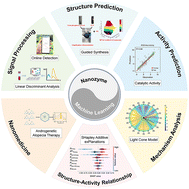Machine learning in nanozymes: from design to application
Abstract
Nanozymes, a distinctive class of nanomaterials endowed with enzyme-like activity and kinetics akin to enzyme-catalysed reactions, present several advantages over natural enzymes, including cost-effectiveness, heightened stability, and adjustable activity. However, the conventional trial-and-error methodology for developing novel nanozymes encounters growing challenges as research progresses. The advent of artificial intelligence (AI), particularly machine learning (ML), has ushered in innovative design approaches for researchers in this domain. This review delves into the burgeoning role of ML in nanozyme research, elucidating the advancements achieved through ML applications. The review explores successful instances of ML in nanozyme design and implementation, providing a comprehensive overview of the evolving landscape. A roadmap for ML-assisted nanozyme research is outlined, offering a universal guideline for research in this field. In the end, the review concludes with an analysis of challenges encountered and anticipates future directions for ML in nanozyme research. The synthesis of knowledge in this review aims to foster a cross-disciplinary study, propelling the revolutionary field forward.

- This article is part of the themed collections: Biomaterials Science Emerging Investigator Series and Biomaterials Science Recent Review Articles, 2024


 Please wait while we load your content...
Please wait while we load your content...